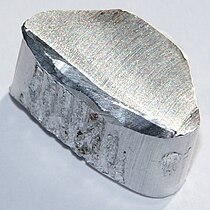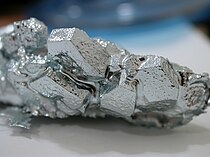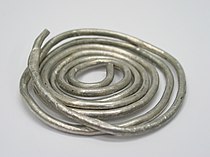
Back Boorgroep Afrikaans Grupo d'o boro AN مجموعة البورون Arabic Elementos del grupu 13 AST Dövri sistemin 13-cü qrupu Azerbaijani Seka boron BAN Група 13 на периодичната система Bulgarian বোরন শ্রেণি Bengali/Bangla 13. grupa hemijskih elemenata BS Grup 13 de la taula periòdica Catalan
| Boron group (group 13) | |||||||||||
|---|---|---|---|---|---|---|---|---|---|---|---|
| |||||||||||
| ↓ Period | |||||||||||
| 2 | Boron (B) 5 Metalloid | ||||||||||
| 3 | Aluminium (Al) 13 Other metal | ||||||||||
| 4 | Gallium (Ga) 31 Other metal | ||||||||||
| 5 | Indium (In) 49 Other metal | ||||||||||
| 6 | Thallium (Tl) 81 Other metal | ||||||||||
| 7 | Nihonium (Nh) 113 other metal | ||||||||||
|
Legend
| |||||||||||
The boron group are the chemical elements in group 13 of the periodic table, consisting of boron (B), aluminium (Al), gallium (Ga), indium (In), thallium (Tl) and nihonium (Nh). This group lies in the p-block of the periodic table. The elements in the boron group are characterized by having three valence electrons.[1] These elements have also been referred to as the triels.[a]
Several group 13 elements have biological roles in the ecosystem. Boron is a trace element in humans and is essential for some plants. Lack of boron can lead to stunted plant growth, while an excess can also cause harm by inhibiting growth. Aluminium has neither a biological role nor significant toxicity and is considered safe. Indium and gallium can stimulate metabolism;[3] gallium is credited with the ability to bind itself to iron proteins. Thallium is highly toxic, interfering with the function of numerous vital enzymes, and has seen use as a pesticide.[4]
- ^ Kotz, John C.; Treichel, Paul & Townsend, John Raymond (2009). Chemistry and chemical reactivity. Vol. 2. Belmont, Ca, USA: Thomson Books. p. 351. ISBN 978-0-495-38712-1.
- ^ Greenwood, Norman N.; Earnshaw, Alan (1997). Chemistry of the Elements (2nd ed.). Butterworth-Heinemann. p. 227. ISBN 978-0-08-037941-8.
- ^ Pharmacology and Nutritional Intervention in the Treatment of Disease edited by Faik Atroshi, page 45
- ^ Dobbs, Michael (2009). Clinical neurotoxicology: syndromes, substances, environments. Philadelphia, Pa: Saunders. pp. 276–278. ISBN 978-0-323-05260-3.
Cite error: There are <ref group=lower-alpha> tags or {{efn}} templates on this page, but the references will not show without a {{reflist|group=lower-alpha}} template or {{notelist}} template (see the help page).
© MMXXIII Rich X Search. We shall prevail. All rights reserved. Rich X Search




